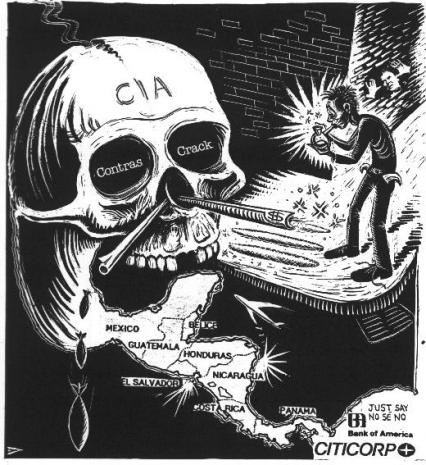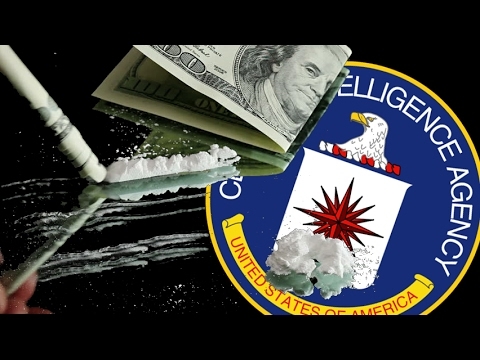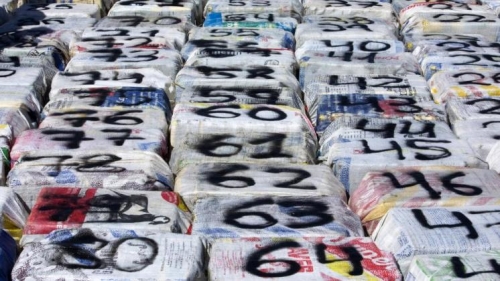Ex: http://www.usa.forzanuova.it
Summary
We know for sure that:
– Western countries have organized drug trafficking in the past;
– there is a strong drug industry existing;
– there are no individuals who have illicit assets comparable to the huge profits generated by the drug industry.
The only logical conclusion is that, largely, the profits from the drug industry do not end up in private hands, but the Western states have never ceased organizing the drug trafficking.
The Dark State
Drug trafficking is significantly profitable. Recent estimates place the drug industry at around 4,000 billion dollars in turnover [1]. Considering a profit margin of only 25% [2], it means that the drug industry is generating profits of 1,000 billion dollars every year. To put it simply, let’s assume that the global organized crime as a whole generates annual profits of 1,000 billion dollars from illegal activities (drugs, prostitution, traffic of persons, organs, cyberthefts, etc). Summing up these profits year by year, decade by decade, we come to astronomic amounts of tens, maybe even hundreds of thousands of billions of dollars. Let’s assume that the cumulated profits over the past 30 years sum up to 30,000 (30×1,000) billion dollars [3]. In order to understand the magnitude of these amounts, we can compare them with the capitalization of all the world’s listed companies, which amounts to around 50,000 billion dollars [4].
It is absurd to believe that people in the organized crime risk their life to make such profits and then they do not spend the money gained. It is absurd and impossible given that the US money supply is around 2,000 billion dollars [5]. Organized crime has definitely changed these profits for something, because, otherwise, there would be no money in circulation around the world. The question is, what has the organized crime changed these profits for? Surprisingly, organized crime has not invested these profits in legal businesses, because it would have been possible for it to buy more than half of all large global businesses. There is no knowledge of a single industry or large company to be financed from illegal money. Organized crime has not invested these profits in properties either (buildings, cars, etc.) because all these are known to the states for tax purposes. Regardless of what they changed these profits for, the question is how it was possible for huge amounts of money to be spent and there is not even one billionaire to have had made a fortune out of illegal activities? The world’s richest persons include no such examples of people enriched from illegal activities.
There are only two single forms of property: private property and public property. If such huge profits cannot be traced back to the world’s private property, this means they were obtained and used by the state. Such profits were spent, year by year, by states and are, thus, not found in any private property around the world.

From a historical point of view
It is known that Western countries are the ones who used to organize drug trafficking in the past [6]. History tells us what happens when drug trafficking is interrupted. The first opium war [7] and the second opium war show that the British Empire, in order not to lose the huge profits generated from drug sale, is willing to use military force to resume the drug traffic. In 2001, the Taliban in Afghanistan had largely stopped drug production [8]. Within only a few months, the Taliban, without funds of billions of dollars, without advanced technology, without satellites, without state-of-the-art surveillance means, had stopped 90% of the drug production. The terrorist attacks of 2001 happened the same year. The person guilty of these attacks had hidden in the same country where drug production was stopped. Over the following year, in 2002, after military intervention, particularly from the US, the drug production had returned to the previous level of 2001, and doubled within 5 years (2006)[9]. Thus, when organized crime received a deadly hit, the US army came to the rescue. The same correlation between military presence and increase of drug production can also be noted in the British army [10].
From an economic point of view
Assume there is a business generating huge annual profits in the amount of a few hundreds of billions of dollars. We can rank down all global companies in terms of profitability. Within only a few years, the most profitable company can be purchased. Using the initial profit, plus the profit of the company purchased, the following ranked company is purchased. Repeating this algorithm, we can understand that there is only a matter of time until the entire economy is controlled by those who own the initially extremely profitable business. Given that, in reality, this business exists and that is the drug trafficking business, there are two possibilities: either all the rich persons are only puppets in the hands of organized crime, or the rich persons altogether control the organized crime (by means of the state).
A general rule of human society is wealth concentration. Applying this rule to the drug industry, we obtain the following:
– in time, the wealth coming from drugs would be found in the possession of a closed group of individuals whose personal wealth is tens of times higher than that of the richest person on the planet;
– America would be dominated by 2-3 mega criminal groups just like all industries ended up being dominated by a small number of giants.
Both versions fail to correspond with reality. Thus, we either accept that a general rule exceptionally does not apply, or we accept that it applies and there is one single criminal group which monopolized America: the State. Thus, there are no rich persons whose wealth is owed to illegal activities because, largely, the profits do not end up in private hands, but the state takes care that criminal groups are small-sized so as not to create great problems to the society. Profits are made by organizers in transit, between the producing country and the market. Drugs are purchased at a price, so that the producer stays poor, and sold at a price close to the street price, so that the seller is not allowed to get rich.
A suspicious element is the lack of seizures in the amount of billions of dollars. The mass-media relates cases when criminal groups are arrested, but where are the billions of dollars they had made in the meantime and hidden as private assets? The private assets cumulated in time are missing, and seizing such fortune would be truly the sensational part of arresting a criminal group.

Let’s consider a clandestine group which makes an annual profit of only 1 billion dollars. With this money, an army of 10,000 people trained to sabotage can be supported. With such an army, a country can be destabilized. For such reason alone, a clandestine group is a serious threat to national security. A state will never allow the existence of such groups, because their clandestine nature means their leadership and purpose for which they were created are unknown. Moreover, the state will not allow either the existence of groups making modest profits. A clandestine group which produces only 100 million dollars every year can raise profits within 10 years and then act. For reasons of national security, we can guess that any major criminal group, regardless of its field of operation, is controlled by the state. The state will not allow any organization (or a different state) to conduct any profit-generating activity without the domestic state knowing of its existence. In order to make 1 billion dollars, more than 60,000 customers are required [11]. How can we believe that the state holds intelligence services able to find terrorist cells of only a few individuals and the same state is not capable to find a network serving over 60,000 customers every year?
Conclusion
From all these different points of view, the American State (Western states) is proven to control organized crime.
The illegality of the Western capitalist system where the state and organized crime are intermingled is simply proven by the lack of great private fortunes made out of drug trafficking. Considering that the annual profits obtained by the organized crime are of only 1,000 billion dollars, we have two options: either the individuals making such profits are different from one year to another, or they are changed every large periods of time. In the first case, hundreds of new multi-billionaires in dollars who had made a fortune in illicit ways would appear every year. In the second case, the illicit wealth gathered in time would exceed the legal profits, meaning those who lead the organized crime would be the richest people of the planet [12]. Given that both versions are false, it means that the profits do not end up in private hands, so the Western countries are still organizing drug trafficking as they did in the past.
1. In its 1997 World Drugs Report the United Nations Office on Drugs and Crime estimated the value of the market at $4 trillion, ranking drugs alongside arms and oil among the world’s largest traded goods.
2. What keeps the drug industry going is its huge profit margins. Producing drugs is a very cheap process. Like any commodities business the closer you are to the source the cheaper the product. Processed cocaine is available in Colombia for $1500 dollars per kilo and sold on the streets of America for as much as $66,000 a kilo (retail). Heroin costs $2,600/kilo in Pakistan, but can be sold on the streets of America for $130,000/kilo (retail).
“The average drug trafficking organization, meaning from Medellin to the streets of New York, could afford to lose 90% of its profit and still be profitable,” says Robert Stutman, a former DEA Agent.
Profit margin (cocaine) (66,000 – 1,500) / 66,000 x 100 = 97.72%
Profit margin (heroin) (130,000 – 2,600) / 130,000 x 100 = 98%
3. Criminals, especially drug traffickers, may have laundered around $1.6 trillion, or 2.7 per cent of global GDP, in 2009, according to a new report by UNODC.
Considering 2009 as the average of the last 20 years we have 1,600 x 20 = 32,000 billion dollars laundered.
4. The total market capitalization of all publicly traded companies in the world was US$51.2 trillion in January 2007[4] and rose as high as US$57.5 trillion in May 2008[5] before dropping below US$50 trillion in August 2008 and slightly above US$40 trillion in September 2008.
6. Despite a major opium epidemic in China at the end of the 19th century, there was little interest in suppressing a business that was so profitable for opium merchants, shippers, bankers, insurance agencies and governments. Many national economies were as dependent on opium as the addicts themselves. Indeed, what Karl Marx described as “the free trade in poison” was such an important source of revenue for Great Powers that they fought for control of opium markets.
100 Years of Drug Control. Antonio Maria Costa – Executive Director – United Nations Office on Drugs and Crime
8. In July 2000, Taliban leader Mullah Mohammed Omar, collaborating with the United Nations to eradicate heroin production in Afghanistan, declared that growing poppies was un-Islamic, resulting in one of the world’s most successful anti-drug campaigns. The Taliban enforced a ban on poppy farming via threats, forced eradication, and public punishment of transgressors. The result was a 99% reduction in the area of opium poppy farming in Taliban-controlled areas, roughly three quarters of the world’s supply of heroin at the time.
9. World Drug Report 2008, p38
11. Considering that 30,000 dollars can be saved annually (out of an average annual salary of 50,000 dollars), that a person gives it all to a criminal group and that the profit margin is 50%, it results that the group is producing 15,000 dollars in profit per client on an annual basis. Dividing a billion to 15,000, we obtain more than 66,000 clients.
12. Considering that there are a million criminal organizations around the world [13], that the incomes from illegal activities are 4,000 billion dollars annually [14] and that wealth distribution is similar to that worldwide, which means that 1% owns 50% of the global wealth [15], we have the first 10,000 criminal organizations which own 2.000 billion dollars. Considering that the distribution of wealth is as follows: 1% own 15% of the wealth, we have the first 100 criminal organizations which hold 300 billion. Considering a distribution similar to that of the richest people on the planet [16] we have the richest organization which has 10.9 billion dollars, while the 100th has 1.5 billion dollars. Based on the profits of one single year, there should be more than a hundred criminal organizations as billionaires. Within only seven years, the accumulated profits would exceed the legal property of the richest man (10.9 x 7 = 76.3 > 75).
Even if, on average, the profits of the organized crime would amount to only 100 billion annually, a wealth of 4,000 billion dollars is obtained within 40 years. It is very hard to believe that this wealth can be distributed so that most traffickers remain poor [17] and the richest trafficker is not among the richest people on earth.
13. In the UK, police estimate that organized crime involves up to 38,000 people operating in 6,000 various groups.
We have 6,000 groups related to Great Britain population of about 60 million. Keeping the proportion of a population of 7.5 billion we have 750,000 criminal groups.
14. Considering and: As reported by the 2013 Europol Serious & Organized Threat Assessment, the “Total Global Impact of CyberCrime [has risen to] US $3 Trillion, making it more profitable than the global trade in marijuana, cocaine and heroin combined.”
17. Contrary to a popular image of drug sales as a lucrative profession, many of the employees were living with their mothers by necessity.
https://www.geopolitica.ru/en/article/dark-state





 del.icio.us
del.icio.us
 Digg
Digg
Les commentaires sont fermés.